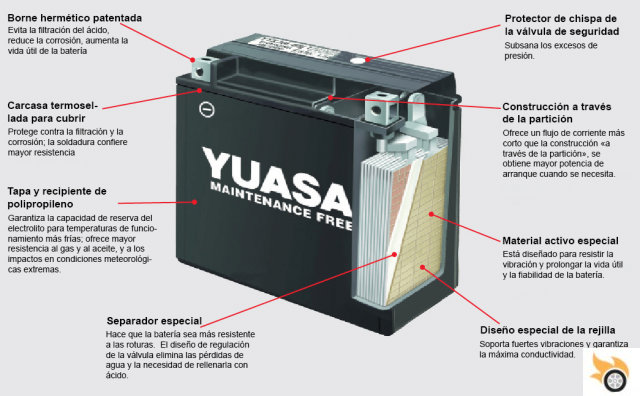
Introduction
Car batteries are an essential component for the proper functioning of our vehicle. However, many times we are unaware of the different types of batteries that exist, how to identify which type our car has and how to carry out proper maintenance. In this article, we'll provide you with all the information you need to understand the different types of car batteries, how to identify them, and how to keep them in top condition.
types of car batteries
There are several types of car batteries on the market, each with its own characteristics and advantages. Here are the most common types:
Lead-acid batteries
Lead-acid batteries are the most widely used in conventional vehicles. These batteries are made up of lead plates submerged in a sulfuric acid solution. They are economical and offer good performance under normal conditions of use. However, they do require regular maintenance, such as checking the electrolyte level and cleaning the terminals.
Gel batteries
Gel batteries are a variant of lead-acid batteries. Instead of using a liquid sulfuric acid solution, these batteries use a thick gel that prevents acid leakage. They are safer and do not require maintenance, but their price is higher than conventional lead-acid batteries.
AGM batteries
AGM (Absorbent Glass Mat) batteries are another type of lead-acid batteries. In this case, the lead plates are separated by an absorbent fiberglass mat. These batteries are more resistant to vibrations and offer greater cold cranking capabilities. In addition, they do not require maintenance and are safer than conventional lead-acid batteries.
Lithium batteries
Lithium batteries are a more modern and advanced option. They are lighter and more compact than lead-acid batteries, making them ideal for electric vehicles. In addition, they offer a greater load capacity and a longer useful life. However, its price is considerably higher than that of lead-acid batteries.
How to identify what type of battery your car has
To identify what type of battery your car has, you can follow these steps:
- Open the hood of your car and locate the battery.
- Observe the label on the battery. It should indicate the type of battery that your car has.
- If you can't find the information on the label, you can look up the battery model number online for more details.
How many types of car batteries are there?
There are several types of car batteries, among which are:
These are the most common types, but there are other, less commonly used variants on the market as well.
Guide to choose the right battery and perform its maintenance
Choosing the right battery for your car is essential to ensure good performance and avoid starting problems. Here we offer you a guide to help you in this choice:
Step 1: Consult the manufacturer's manual
The first step in choosing the right battery is to consult your car manufacturer's manual. There you will find specific information on the type of battery recommended for your vehicle model.
Step 2: Consider cold start capability
Cold cranking capability is an important factor to consider when choosing a battery. This capacity indicates the amount of current that the battery can supply in low temperature conditions. The higher this capacity, the better the battery will perform in cold climates.
Step 3: Check the dimensions and polarity
It's important to make sure that the battery you choose has the right dimensions to fit into your car's battery compartment. In addition, you must verify that the polarity of the battery is correct, that is, that the positive and negative terminals are in the proper position.
Step 4: Perform regular maintenance
To prolong the life of your battery and ensure optimal performance, regular maintenance is necessary. Some recommendations include:
- Check the electrolyte level and top up if necessary.
- Clean battery terminals to prevent corrosion buildup.
- Check the condition of the connection cables and replace them if they are worn.
- Avoid leaving the car unused for long periods of time, as this can discharge the battery.
Frequently Asked Questions (FAQs)
1. How long does a car battery last?
The life of a car battery can vary depending on several factors, such as the quality of the battery, the conditions of use and proper maintenance. In general, a lead-acid battery can last between 3 and 5 years, while gel, AGM, and lithium batteries typically have a longer life of up to 8 years.
2. How can I tell if my battery is failing?
There are several symptoms that can indicate that your battery is failing. Some of them are:
- Difficulty starting the car.
- Dim or flickering lights.
- Problems with the electrical systems of the car, such as the windows or the audio system.
- The battery discharges quickly.
If you experience any of these symptoms, it is advisable to take your car to a specialized workshop to have the condition of the battery checked.
3. Can I use a lithium battery in a conventional car?
Yes, it is possible to use a lithium battery in a conventional car. However, you should keep in mind that these types of batteries are usually more expensive than lead-acid batteries and may require modifications to the car's electrical system. Also, it is important to ensure that the lithium battery is compatible with your car's specifications before installation.
Conclusion
In summary, it is important to know the different types of car batteries that exist, how to identify which type our car has and how to carry out proper maintenance. Lead-acid, gel, AGM, and lithium batteries are the most common options on the market, each with their own advantages and characteristics. When choosing a battery, it is essential


























